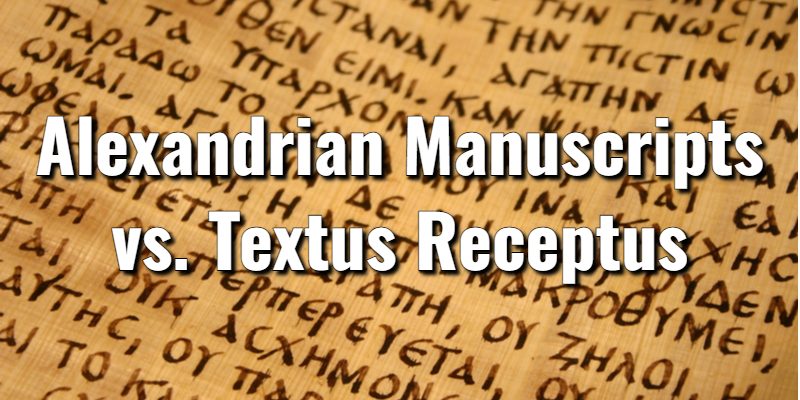Lord’s Library editors explore various Christian foundations by comparing the Alexandrian Manuscripts vs. Textus Receptus.
Before there were a multitude of different Bible versions in print, disparate scrolls and manuscripts made up the bulk of available resources on Scripture. These documents were fragmented from East to West, copied by scribes from earlier sources, or translated from material in different languages. Over time, textual changes were made, and, as a result, inaccuracies crept into the different copies either by mistake or through translation. This has resulted in thousands of different textual Bible variants today.
There are two main groupings that have been responsible for the bulk of different Bible translations we know today; the Alexandrian Manuscripts and the Textus Receptus. With this mind, Lord’s Library editors created this resource to help you understand the Alexandrian Manuscripts vs. Textus Receptus for effective comparison. Our aim is to help you understand the origin of a majority of modern Bible translations and ultimately decide which version is right for you.
Alexandrian Manuscripts vs. Textus Receptus
What is the Alexandrian Manuscripts? Alexandrian Manuscripts Definition
In the 19th century, two previously unrecognized New Testament texts appeared. These were called Codex Vaticanus and Codex Sinaiticus. They were found (in excellent condition) in the Vatican Library and a monastery in the Sinai. These texts are dated to the late 3rd-early 4th centuries.
Neither manuscript was in the original Greek language. They were both Coptic translations, an early Egyptian language. Because both manuscripts were in the Coptic language, scholars placed their origins in the region of Alexandria, Egypt. As a result, they became known collectively as the Alexandrian Manuscripts. Bible scholars of the times believed that since these two texts were older than any of the 5,000 that had been used by the 1611 King James committee, they might reveal a more authoritative text, being closer in time to the events described in the New Testament.
The differences in the Alexandrian Manuscripts were many. To start, the resurrection story in the book of Mark was no more. Acts 8:37, where the Ethiopian eunuch confesses Jesus as the Son of God, was missing as well, along with other passages. Since the Alexandrian Codices were older than any document in the Textus Receptus, it was believed that these verses (that the Apostles wrote) did not exist in the original manuscripts and were thus added by eager scribes sometime between the 3rd and 5th century.
This was the prevailing theory up until the 1960s. All the modern translations which were written during this time were based on the Westcott and Hort Greek text, including the American Standard Version (ASV), the New International Version (NIV), the New World Translation (NWT), and even the New KJV (NKJV). This happened because the codices were considered more accurate.
The Alexandrian Manuscripts are the ancient Biblical manuscripts preferred by modern Bible scholars. These manuscripts are preferred because they feature less of a tendency to expand upon the original text, or paraphrase. They are often found to be concise and to-the-point, which remains a sticking point for modern textual critics. These manuscripts serve as the base text for most Bible translations produced after 1900.
There is great accuracy present between all extant manuscripts of the Alexandrian type. These manuscripts are as least 85 percent identical to one another. Modern Bible scholars believe these Alexandrian manuscripts boast the most accurate readings of the New Testament texts available.
Alexandrian Manuscripts Defined
What is the Textus Receptus? Textus Receptus Definition
The King James Version of the Bible, the best-selling Bible of all time, was translated using the Textus Receptus.
Textus Receptus is Latin for “Received Text.” It was used as the textual base for the vernacular translations that arose during the Reformation period. As that period also gave rise to the printing press, Bibles were available to the masses for the first time in history. This created a need for Bible translations in people’s native languages.
Sadly, the vernacular translations were created quickly and not always under trained hands. In light of this, many errors arose in the various translations. This made it so a textually accurate Greek New Testament was needed. The Textus Receptus was a printed text (not a hand-copied manuscript) that fulfilled this need.
Erasmus, a 15th-century Dutch theologian, went to work and created a Greek New Testament with hand-copied Greek manuscripts dating back to the twelfth century. This Greek New Testament was first published in 1516, becoming a best-seller. A second edition followed in 1519 which corrected some errors found in the original version.
For the next 250 years, the Textus Receptus, Erasmus’s Greek New Testament, became the dominant Greek Text of the New Testament. Most Bible translations of that era were based upon his work. Only in 1881 was it dethroned by the Westcott and Hort Greek New Testament. The Westcott and Hort Greek New Testament was birthed from the rise of textual criticism. Erasmus’ Textus Receptus was not perceived as being a “bad” translation, but rather a text produced in a time with fewer resources and scholarly wisdom.
The Textus Receptus, despite one’s beliefs for or against it, had a profound influence on preserving God’s Word through many centuries. Textual criticism of the Scriptures is so important that all scholars and students of the Word of God need to utilize its principles in order to fulfill the Biblical mandate stated in 2 Timothy 2:15:
“Study to shew thyself approved unto God, a workman that needeth not to be ashamed, rightly dividing the word of truth.”
Textus Receptus Defined
Alexandrian Manuscripts vs. Textus Receptus; What’s the Difference?
There are over 5,800 different New Testament manuscripts available to Bible scholars. They have been divided into four main text types: Alexandrian, Western, Cesarean, and Byzantine. The Alexandrian Manuscripts fall into their own grouping while the Textus Receptus was a Greek translation of the Bible based on various manuscripts from the Byzantine grouping.
There is much contention over which manuscripts should be favored for use in modern Bible translations. This debate rages on between those who hold firmly to a King James only belief (based on the accuracy of the Textus Receptus) and those who are willing to embrace the modern Bibles based upon the Alexandrian Manuscripts.
Lord's Library participates in affiliate programs. We may make a small commission from products purchased through this resource.
- What Does the Bible Say About Achievements? With Key Scriptures - April 11, 2025
- What does the Bible Say About Abortion? With Key Scriptures - April 11, 2025
- Prosperity Gospel Meaning in the Scriptures: Is it Biblical? - April 7, 2025











